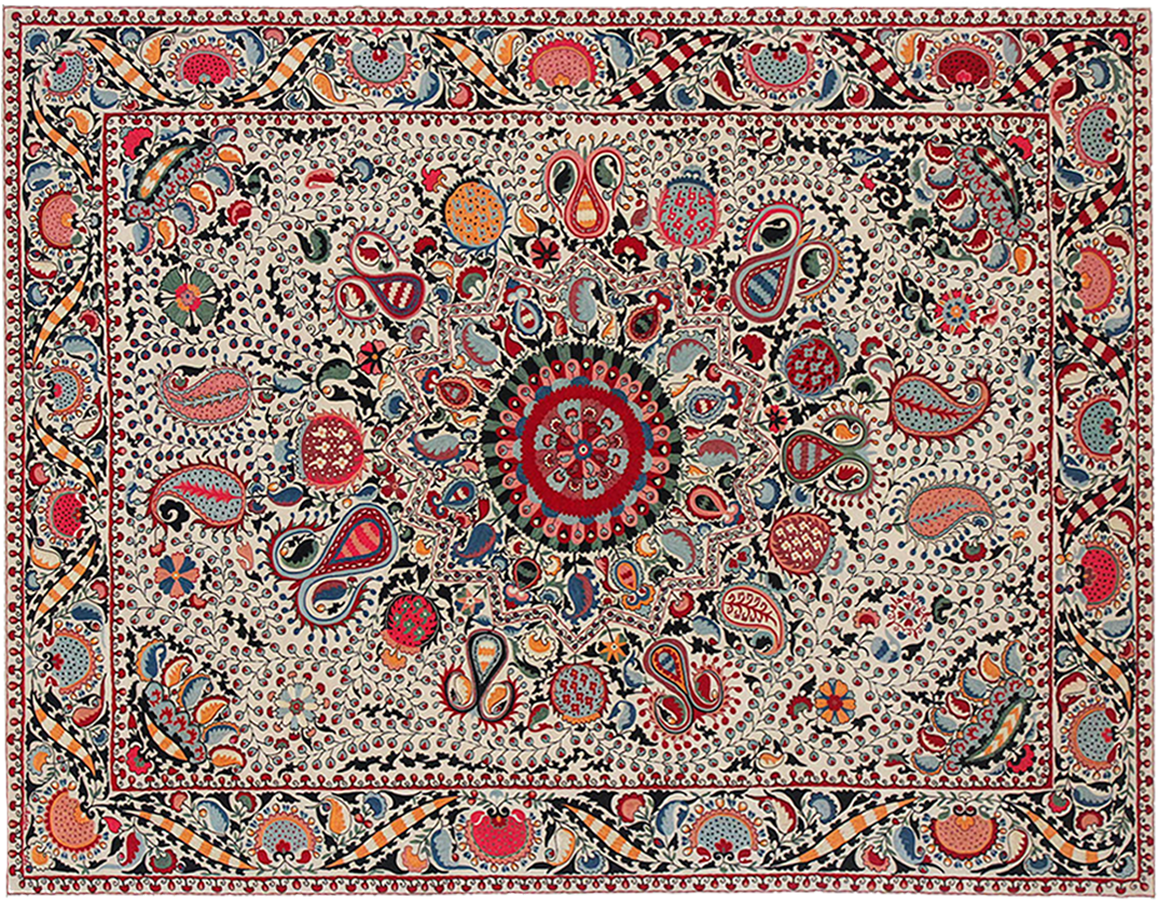Music, geometry, symmetry and asymmetry, fantasies, dreams, gardens of Eden and birds living there and finally the history – one of the most important, but not the last element, which is reflected in suzani. Suzani in Persian means “embroidered with the needle”. I would add to translation embroidered with the angel patience, health, kindness and love. By the way about the kindness, I have never met disgruntled or displeased master of suzani. As usual these women (masters of suzani are mostly the women) are friendly, their smile, voice and treatment are modest and unobtrusive. They spread out their speech with the calm voice as if they do the stich after the stich of incredible beauty pattern.
Exactly like this I met my quid to the suzani`s world- Madina Kassimbaeva. The first time I have seen Madina`s works I knew nothing about this kind of needlework and only my eyes felt esthetic pleasure. Master`s modesty, kindness and strength of will won my heart. Madina is an honored master of suzani, member of Association of the craftsman of Uzbekistan, head of the educational programs of suzani and also for the people with disabilities.
Madina was grown in the family of craftsmen’s. In the age when a child only learns to keep pencil Madina has already dexterously treated with the needle, helping her mother and grandmother to embroider. Professional destiny of the girl was determined. Further she continued her education in the Lyceum of applied arts of Uzbekistan. For the successes in the embroidery with the gold threads “zarduzlik’ Madina got master degree. And from that moment her teaching practice has begun. In parallel she was trying to rebirth the ancient technique of the national embroidery. Particularly master interested in the technique “yurma” that means “embroidered with the crochet”. Finally finding the origins of the lost technique in Margilan she successfully learned it.
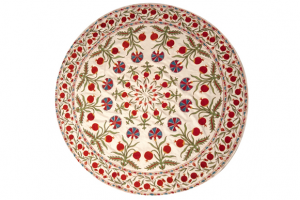
The improved skills of the new technique master complete with the hand painted silk and cotton fabrics, selected silk threads, colored with the natural colorants (common madder, walnuts shells, pomegranate peels and others). Finishing scrupulous selection of the raw materials the master begins work with the pattern. The pattern is drawn on the fabric and then the fabric is stretched on the loom. Usually the pattern is painted by professional painters “kalamshik’ but some masters of suzani do this work by themselves. To embroider one little element of the pattern the master should fill it with tens stiches made by the thin crochet. So it takes approximately 15 days to prepare one little pillowcase.
Thanks to her mastery Madina became the often quest at the international exhibitions. Once get acquainted with her work you will certainly recognize them in your city be it Milan, Baku, Moscow, Seoul or New York.
Madina`s creative works encouraged me to find the secret of immortality of suzani as a the kind of art.
History gives us some facts about the time of appearance of suzani. First in the 10 century the famous historian from Bukhara Narshakhi mentioned in his diary that: “Women in Central Asia use different colors of threads for embroidery”. One more fact about suzani gave Ruy Gonzalez de Clavijo in the beginning on 15 century when he visited Sanarkand. Ruy Gonzalez de Clavijo made the descriptions of the patterns of suzani which he had seen.
Obviously in that period the peculiar ceremonies and beliefs related with suzani were starting to form. For example, as the process of embroidery required the imagination, working capacity, ransom for the bride (kalim) with the skills of suzani rose repeatedly. The decoration with richly embroidered suzani was a confirmation of welfare of the person. It is interesting to mention that suzani was the main dignity of the bride`s dowry, which she has began to prepare to herself being a girl. There is one more wont followed by embroideries. It is necessary to leave small part of suzani incomplete in order to the thread of happiness doesn`t interrupt and the weddings in the house never end.
To create patterns of happiness to skilled masters allow several kinds of stiches. The mentioned earlier “yurma” style more known as tambour stitch something between sewing and knitting. Techniques “bosma” and “kanda-hayol” (widely applied in old times in Urgut) related with the couched stitch technique which form dense and slightly relief surface. One more kind of stich is “iroki” – half-cross miniature stich, which create the pattern with the grainy surface.
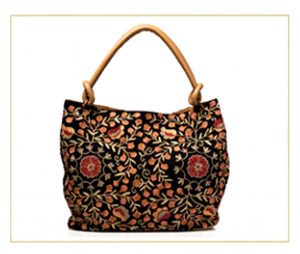
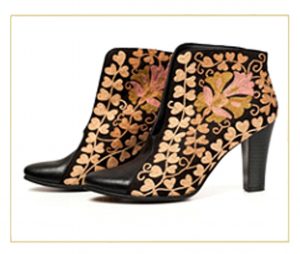
The main component of suzani is her regional attachment. On the suzani`s map the most famous are Nurata, Bukhara, Urgut, Shakhrizabs, Tashkent and Ferghana schools of embroidery.
Distinctive feature of Bukhara school is the tambour stitch. This style mostly uses enclosed composition with many small details and accents in the middle and the corners of the work. One of the most popular patterns is the round rosette and wide richly ornamented bordure. Bukhara`s style of embroidery also called the emir`s style because of the influence of Bukhara`s emirate on this kind of art.
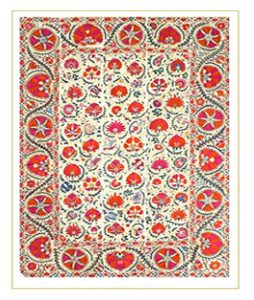
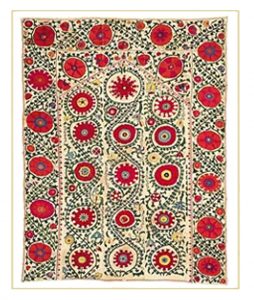

Impress by their creativity the embroideries of Shakhrizabs. More often they use the tambour stitch on the colored background. The patterns of Shakhrizabs are the medallions in the center and their quarters in the corners. The patterns often compared with the ones of the carpets. And small products as belts and purses are made with the stich “iroki”. At the beginning of 20 century the works of embroiders of Shakhrizabs were especially popular at the court of emir of Bukhara and between its foreign guests.
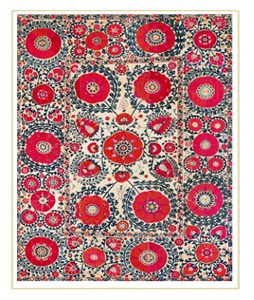
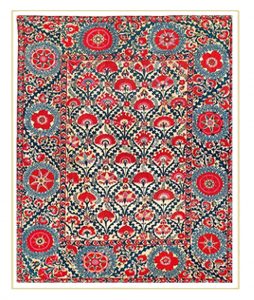
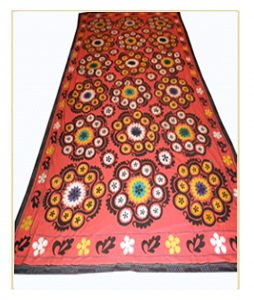
Regarding to distinctive features of Samarkand suzani it is primary red and black colors on a white background and “basma” stich. One more characteristic attribute of Samarkand suzani is a narrow border which frames the field of embroidery. From historical point it is interesting to consider how the bourgeois estate at the 19-20 centuries influenced on the formation of the Samarkand patterns. The aspiration of the rich people who were buying the suzani to stand out made the pattern bigger. It was meant that the man was reach and had an opportunity to order the pattern which required more silk threads.
On the suzani of Urgut we see the influence of Samarkand as closest territorial neighbor. Nevertheless the patterns of Urgut go its unique feature. The patterns of Urgut are formatted by the principle of “background free pattern”. Secret is the gleams of the fabric between the main pattern forms elegant graphic pattern itself. Two patterns complete each other gracefully.
They say if gardens of heaven came to life on your eyes you see the suzani of the masters of Nurata. The color schedule is various. The fairy birds and animals live in heaven gardens of Nurata.
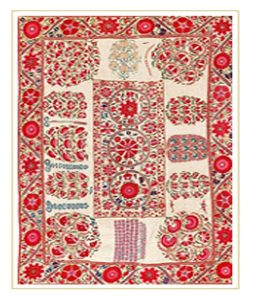


The style of suzani of Fergana school different in the free location of the pattern on the violet or green silk. The main pattern is “ruijo” (repeated motive of the bush with the flowers) or “gulkurpa” (flower blanket).
The suzani of Tashkent different in the patterns of “palak” (sky) and “gulkurpa” (flower blanket). The motives of “palak” are the big red circles widely located on the cloth. And the “gulkurpa” is always served as decoration of the blanket for the newlywed.
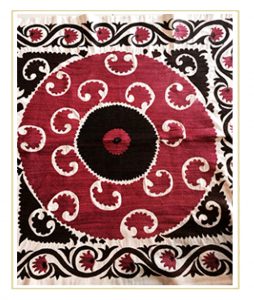
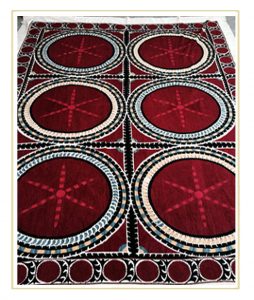
All schools of suzani with their features are united first of all by commitment to traditions. As in former days the masters of suzani prefer handmade fabrics and for silk threads – natural colorants. And the reason is not the progress something difficult to acquire for traditional kind of art. The thing is the simplification or modernization of the process is not implied by the philosophy of suzani. If the masters of suzani scarify to their works their health think weather costs to save on materials. Sometimes to embroider one panel takes a few years. Loss of eyesight, pane in the backbone lay in each work prepared by embroideries. You can ask whether the result costs all the sacrifices. For myself I decided that it isn’t` matter costs it or not. The people sacrificed for the art even their lives. The Egyptian pyramids, gardens of Versailles, musical masterpieces, pictures, poetry and many other things to what people appeal with aspiration, have left an indelible heritage for the mankind. And suzani is kind of art which absorbed historical milestones, religious beliefs, national traditions, dreams and expectations of the people. This invaluable work of skilled embroiders will always cause the inexplicable with words admiration.

 Language
Language